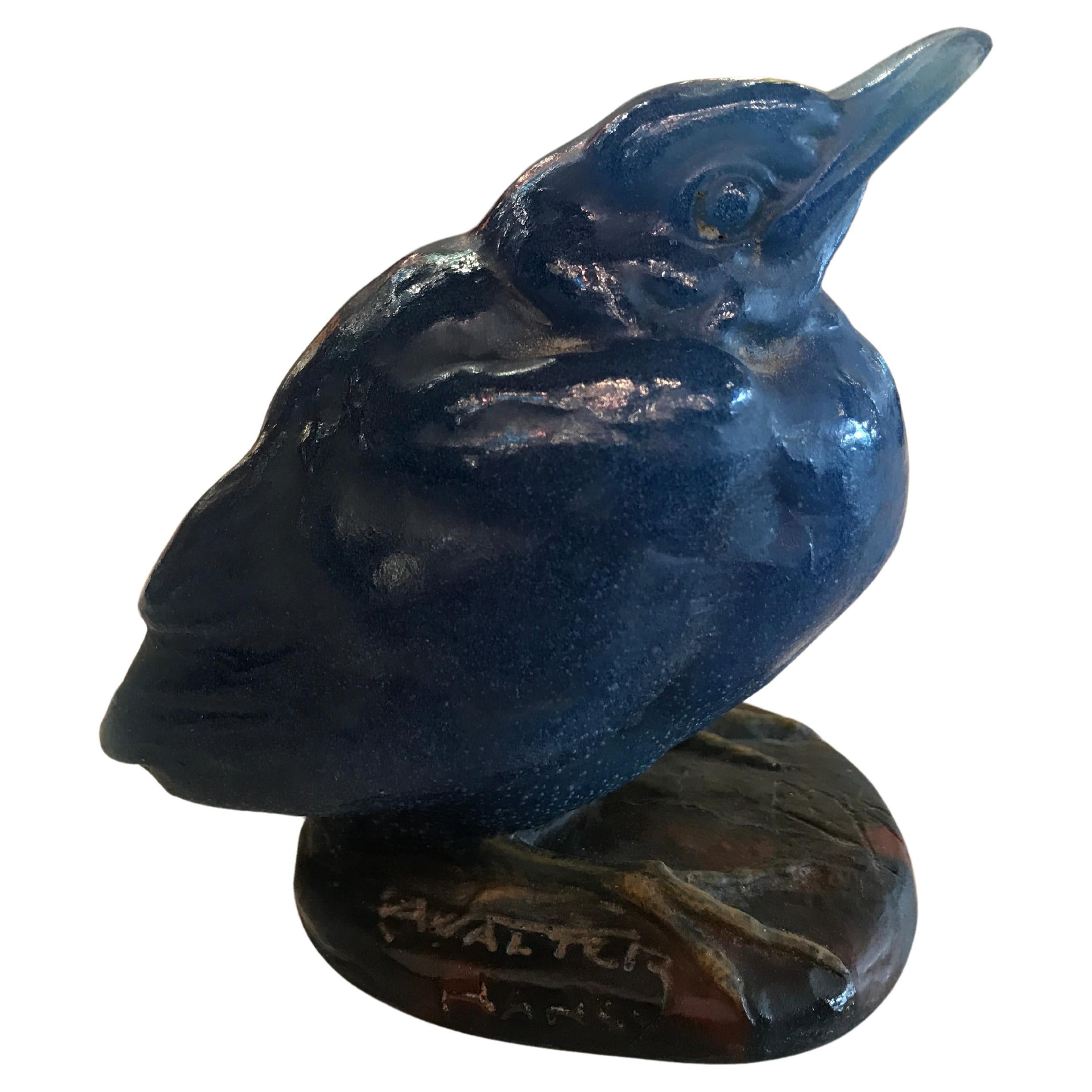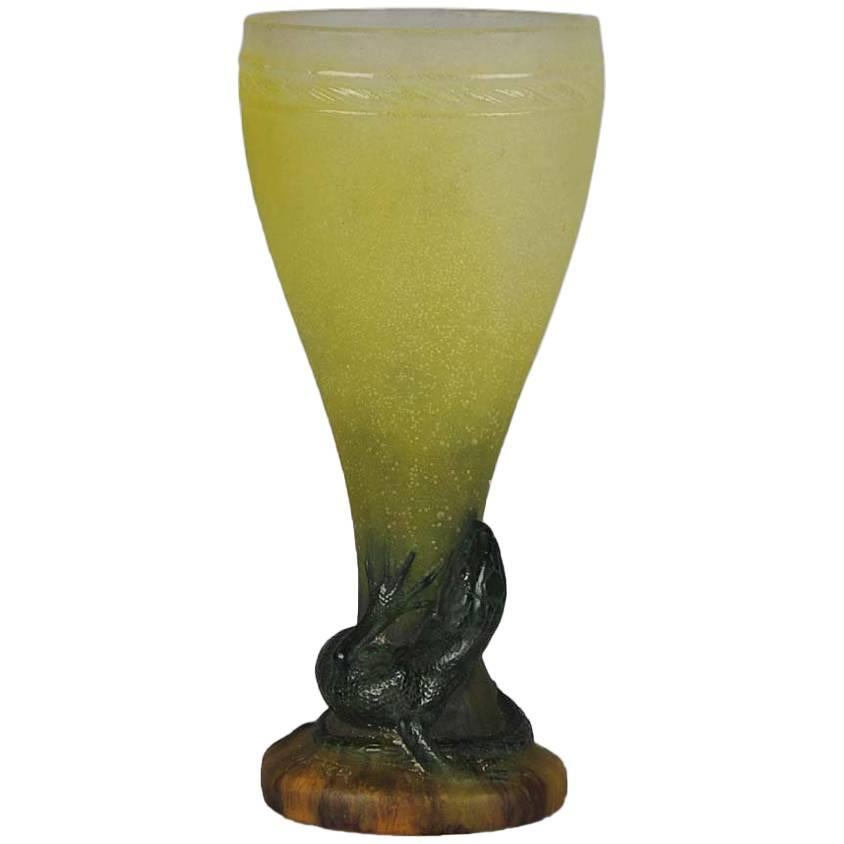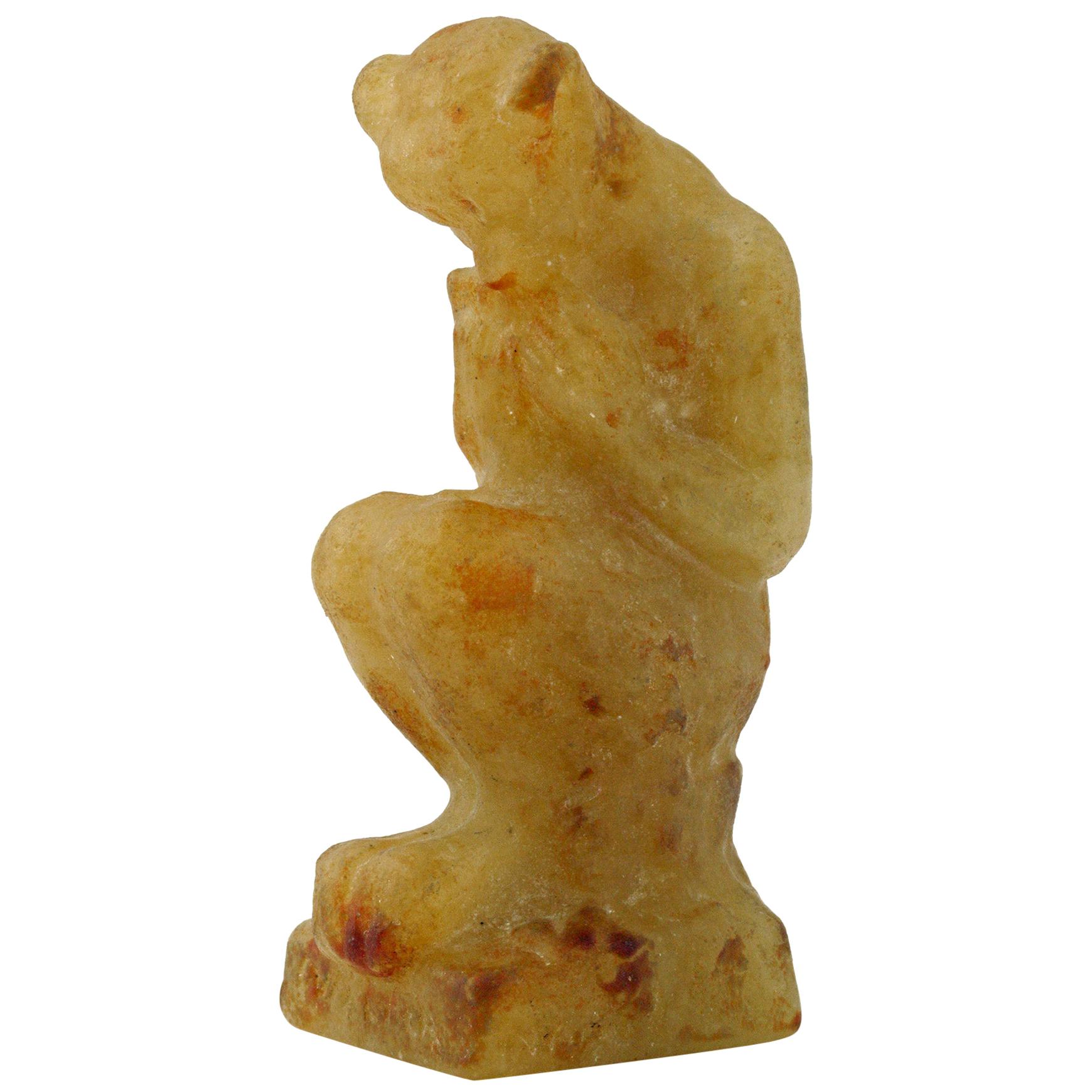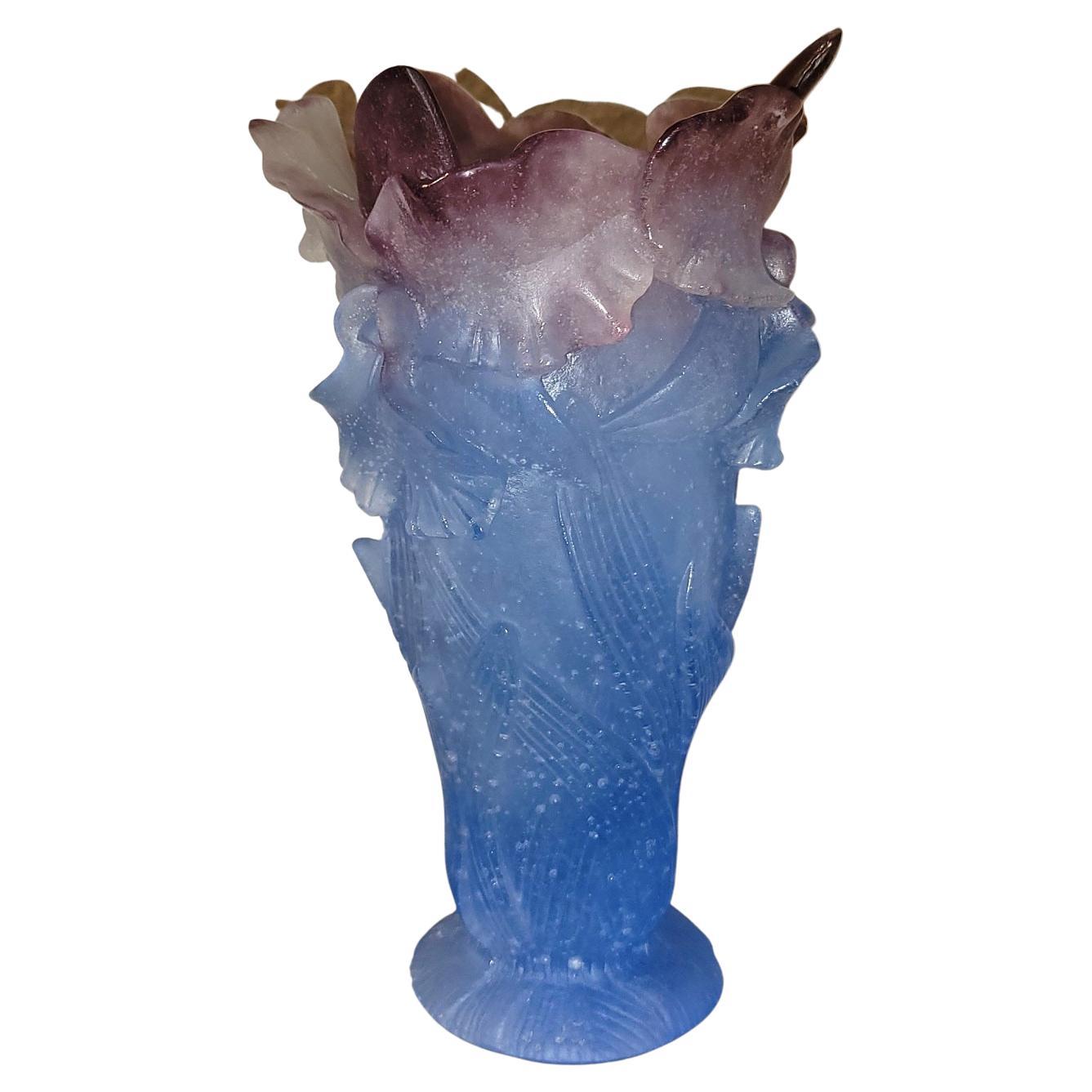Items Similar to Energetic Glass Buddha by Almeric Walter, Pate de Verre, France, 1900s
Want more images or videos?
Request additional images or videos from the seller
1 of 16
Energetic Glass Buddha by Almeric Walter, Pate de Verre, France, 1900s
About the Item
Amalric Walter (français, 1870-1959)
A wonderful energetic Glass or Chrystal Shakyamuni Buddha by Almeric Walter from the Art Nouveau, Art Deco period circa 1920. These Buddha figures are rare as most Walter Pate de Verre models. Why copper or bronze when you can have glass.
Signed: A. WALTER NANCY and Bergé.
Victor Amalric Walter (19 May 1870 – 9 November 1959) was a French glass maker mainly known for his pâtes de verre pieces.
Born in Sèvres on 19 May 1870, Waltr first worked at the Manufacture nationale de Sèvres, near Paris, where he decorated and glazed earthenware pieces. He won a bronze award at the National and Colonial Fair of Rouen in 1896 and a gold award at the International Work Faire of Paris in 1901. He was impressed by the pâtes de verre of Albert Damousse, Decorchemont, Argy Rousseau and Henri Cros who received the Gold Medal of 1900 World's Fair.
He then decided to work for the Cristalleries Daum Nancy, France, from 1904 or 1905, where he stayed until the first World War in 1915. There, he met a designer/modelist, Henri Bergé, with whom he made pâtes de verre always signed "Daum Nancy", without his name nor Bergé's name. With his help, he cast around 100 different models; but few of these pieces from this period were preserved so far. He help decorating the living room of the Maison Losseau in 1911 with 15 pâte de verres representing the Belfry of Thuin and the river Sambre.
After the war, he decided to create his own glass studio at Nancy, rue Claudot. He continued his collaboration with Henri Bergé. From 1919-1935 with Bergé and other famous sculptors or designers, he cast not less than 500 models, always in few numbers due to the sophisticated technique of glass kiln casting. It is said that when he was not happy about pieces that came out from the kiln, he used to throw them onto the outside wall of his studio, saying he was a genuine perfectionist. His staff was not numerous (8-10 workers maximum).
Art Deco began to replace Art Nouveau, and Arts & Crafts production or small business sector became non-competitive due to high manufacturing costs. He then reoriented his production and cast simpler pieces, influenced by Art Deco design. Most of his pieces of the later period involve at most three colors, to reduce costs.
After 1935, Walter's workshop closed. He also progressively became blind. He died on 9 November 1959, blind and destitute, at Lury-sur-Arnon where he was visiting a friend.
Walter's work and glass casting process was neglected after his death. The Amalric Walter Research Project was launched in 2006 by Keith Cummings and Max Stewart in Dudley, England. At the same time an exhibition on Walter's pâtes de verre was held at the Broadfield House Glass Museum.
- Creator:A. Walter Nancy (Artist)
- Dimensions:Height: 3.55 in (9 cm)Width: 3.15 in (8 cm)Depth: 2.37 in (6 cm)
- Style:Art Nouveau (Of the Period)
- Materials and Techniques:
- Place of Origin:
- Period:
- Date of Manufacture:1900-1920
- Condition:Wear consistent with age and use.
- Seller Location:Buenos Aires, AR
- Reference Number:1stDibs: LU2027314613541

About the Seller
4.9
Vetted Seller
These experienced sellers undergo a comprehensive evaluation by our team of in-house experts.
Established in 2002
1stDibs seller since 2016
284 sales on 1stDibs
Typical response time: <1 hour
- ShippingRetrieving quote...Ships From: Buenos Aires, Argentina
- Return PolicyThis item cannot be returned.
More From This SellerView All
- Desk Equestrian Horse Racing Cigar Smoking Box, circa 1900sLocated in Buenos Aires, OlivosEquestrian cigar box with space for matches. Perfect desk piece. Engraved with racing horses.Category
Early 20th Century American Art Nouveau Tobacco Accessories
MaterialsBrass
- Art Nouveau Loetz Iridescent Glass Vase with Silver OverlayBy Loetz GlassLocated in Buenos Aires, OlivosArt Nouveau glass vase with engraved silver overlay by historic Czech maker Loetz.Category
Early 20th Century Austrian Art Nouveau Vases
MaterialsSterling Silver
- Franz Iffland Bronze Sculpture of a Cupid Boy Ice Skater, ca 1900By Franz IfflandLocated in Buenos Aires, OlivosBronze depicting a young boy (cupid) ice skating, by Franz Iffland (Berlin 1862-1935). A boy in fur-trimmed cape, holds a cupid-like feathered arrow with...Category
Early 20th Century German Art Nouveau Figurative Sculptures
MaterialsMarble, Bronze
- 20th Century Blue French Pierrefonds Pottery Flower Vase, 1900sBy Pierrefonds PotteryLocated in Buenos Aires, OlivosArt Nouveau Pierrefonds pottery vase in tones of blue, tan and brown, partially decorated in crystalline glazes, stamped factory marks. France, circa 1900.Category
Early 20th Century French Art Nouveau Pottery
MaterialsPottery
- Austrian Bronze Bear Cigar Cutter, ca 1900´sLocated in Buenos Aires, OlivosA solid bronze bear sculpture desktop cigar cutter manufactured in Austria. The scissor action steel blades are remove-able form the mouth of the roaring bear. Excellent condition. S...Category
Early 20th Century Austrian Art Deco Tobacco Accessories
MaterialsBronze
- Cigars Store / Trade Folk Art Wooden Carved Sign. c 1900Located in Buenos Aires, OlivosAmerican Folk art wooden "CIGARS" sign from the 1920's. Great old Store Trade sign. Wood cut to cigar shape. Lettered in Gold Paint. In good conditions, it was a in doors sign. Perfect for any cigar smoker. Cigars History: A cigar is basically dried tobacco leaves that are rolled and wrapped by other tobacco leaves in order to give you a full tobacco smoking experience. Cigars are becoming more popular all around the world recently because they are exposed to a pop culture where a lot of famous people like Michael Jordan and Arnold Schwarzenegger smoke them. In order to understand why cigars have become very well-known, we need to take a good look at their history and where they came from. That way, we can truly understand this pop phenomenon. Here is a brief history of cigars. Origin of Cigars The exact origin of cigars is not entirely known but historians believe that cigars were first invented by the ancient Mayans. The ancient Mayans would collect tobacco leaves and wrap them up in a plantain leave in order to smoke it. An ancient Mayan pot...Category
Early 20th Century American Folk Art Signs
MaterialsWood
You May Also Like
- Almeric Walter Nancy Pate de Verre Figural Bumble Bee Pin Tray or Vide PocheLocated in Hamilton, OntarioThis antique pate de verre tray or vide de poche was made by the renowned French artist Almeric Walter Nancy in circa 1910 in an Art Nouveau style...Category
Early 20th Century French Art Nouveau Glass
MaterialsArt Glass
- Art Glass, A. Walter, (Pâte de verre vide-poche by Amalric Walter), FranceBy Almeric WalterLocated in Ciudad Autónoma Buenos Aires, CPâte de verre vide-poche by Amalric Walter. Born in Sèvres on May 19, 1870, Walter first worked at the Manufacture nationale de Sèvres, near Paris, where he decorated and glazed ear...Category
Vintage 1920s Austrian Art Nouveau Figurative Sculptures
MaterialsArt Glass
- Art Deco Pate-De-Verre Glass 'Lizard Vase' by Amalric WalterBy Amalric WalterLocated in London, GBA fantastic and very rare early 20th century pate-de-verre glass vase decorated with a lizard coiled around the bottom with a very fine orange and green color that fades out into yel...Category
Vintage 1920s French Art Deco Glass
MaterialsArt Glass
- Art Nouveau Pâte De Verre Vide-Poche 'Deux Poissons', Amalric Walter, FranceBy Amalric WalterLocated in Vienna, ATDecorative pâte-de-verre vide-poche: bowl in yolk yellow, one side overflowing in dark blue, swimming around each other, plastically formed goldfish couple. Signed 'AWALTER NANCY' on the top. Manufactory: Amalric Walter, Nancy, Lorraine, France Dating of manufacture: circa 1920/1925 Designer: VICTOR AMALRIC WALTER (1870-1959) was a French glass manufacturer mainly known for his pâte de verre pieces. In the Cristalleries Daum at Nancy, France, he met the designer and modelist HENRI BERGÉ, with whom he produced the first pâtes de verre, which at the time were only signed with "Daum Nancy". After the war he continued to work with Henri Bergé. From 1919 to 1935 he cast no fewer than 500 models with Bergé and other famous sculptors or designers, always in few numbers due to the sophisticated technique of glass kiln casting. Technique: Pâte de verre (English glass paste) is a technique used in the production of multi-colored glass. A cold-formed paste made of glass powder and dyes is filled into a refractory mold and then fired in a muffle furnace, whereby the glass melts into the desired shape. To achieve polychrome color effects, the process is repeated with other colors. The technique was already known in ancient Rome and Egypt. Particularly in the Art Nouveau period and later in the Art Deco period, she found artistic use again in works by French glass artists such as Gabriel Argy-Rousseau, Henry Cros...Category
Vintage 1920s French Art Nouveau Glass
MaterialsGlass
- Almaric Walter Pâtes de Verre Art Glass Figure of Pan Playing his PipesBy Almeric WalterLocated in Bishop's Stortford, HertfordshireA rare and fine French pâtes de verre cast glass figure of Pan by Victor Amalric Walter and believed to have been made in Nancy circa 1920. This charming...Category
Vintage 1920s French Art Nouveau Glass
MaterialsGlass
- Daum Orchid Amethyst Pate de Verre VaseBy DaumLocated in Dallas, TXPRESENTING A STUNNING Daum Orchid Amethyst Pate de Verre Vase. Made by the World renowned French maker of ‘Daum’ of Nancy, France circa 1960-80. Gorgeous art glass piece, hand craf...Category
Mid-20th Century French Art Nouveau Glass
MaterialsArt Glass
Recently Viewed
View AllMore Ways To Browse
Designer Items
Used Designer Items
Items From France
Rare Gold Items
Walter Mader
Antique House Items
Antique Art Deco Items
Glass Kiln
Antique French Art Collectibles
Used Glass Kiln
Items From Art Deco World
Antique Copper Items
Antique Glass Art Collectibles
Small Copper Items
French Sayings
Bronze Verre
Religious Medals Gold
Gold Religious Medalions





